Jan Scharnberg is a physical therapist employed by Grant Wood Area Education Agency, serving schools in the Cedar Rapids district of Iowa.
Eleven delightful students with severe disabilities attend two classrooms at Truman Elementary in Cedar Rapids, IA. Mary Craven, special educator, teaches the younger students, and Lisa Perry has the classroom of older students. Several of these students can walk, but most would be considered “wheelchair-bound”. However, at Truman they are anything BUT bound to their wheelchairs! As the physical therapist serving this school, I love the way Rifton products and the MOVE principles are uniquely implemented in this regular elementary school, as opposed to a Special Education Center.
Every one of these students has a standing program. We use the Rifton Mobile Stander, and aim for an hour a day of standing, per student. We place great value in standing, for maintaining or building bone density as well as maintaining range of motion. Besides the physical benefits, there are also educational and social benefits for students who interact while standing in the classroom and school.
The Rifton Mobile Stander is the easiest commercial stander for transfers. Children benefit physiologically and functionally when they learn to go from sit-to-stand with only as much assist as they really need. With the Mobile Stander, we can get our students to step up into the stander, and while they hold onto the front, we assist them by attaching the straps. Before we had Mobile Standers, we used prone standers that were usually stationary and required the child to be lifted up into it. This often took at least two people and was not necessarily carried through when the students became too heavy to lift.
Our students who use the Mobile Stander don't miss any of the action going on in the room! Instead of being in a stationary stander, placed against a counter top with the wall in front of them and their back to the room, students can interact with the room activity. Students in their Mobile Stander in front of a computer game or TV will use a switch to activate a favorite toy. The TV in Mary Craven's room is set up high enough so the visually impaired children (many are cortically visually impaired) can really get right up there and see it. The switch can be attached to either the frame or the tray of the Mobile Stander. In this way, we encourage movement of the head or hand depending on what we are working on.
One of Lisa Perry's former students, Phillip, had increased tone in his arms and legs. The large wheels of the Mobile Stander allowed him to really work those arms. "He was not only benefiting from standing, but as he moved, he was strengthening and increasing the coordination of his arms," remembers Lisa. Although a very tight quadriplegic with visual impairment, Phillip was smart as a whip. We coached him verbally - where to grab onto the wheels, and how to push forward - and he picked it right up. Other than the Pacer, the Mobile Stander was his only real means of independent movement.
Mary Craven's student, Sammy, cannot even sit up. But we place him in the Mobile Stander. Mary explains, "I teach the younger kids, so I'm working more on head and trunk control with my students.” Once we have Sammy in the Mobile Stander, we can lay his arms on the tray, and then rest his head on its side. Then he works on picking his head up to activate a switch placed above his head on an adjustable arm. That way he works on neck control while weight bearing. He loves watching movies that way.
Sammy is using a switch that he activates when he raises his head.
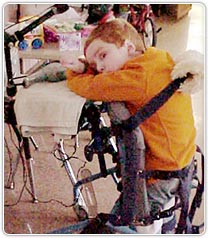 |
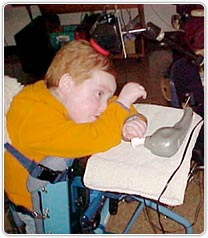 |
 |
Cody has hemiplegia, with very limited use of one arm. He uses a one-arm drive wheelchair. He's carried that skill over into maneuvering the Mobile Stander. We've discovered that we can put just one large wheel on the Mobile Stander, and Cody figured out how to push the wheel forward and then pull back, to straighten the stander out. He is able to maneuver himself around the halls, and he gets out and exercises during exercise time, and he sees his friends.
Cody very deftly maneuvers the Mobile Stander with only one wheel since he is hemiplegic.
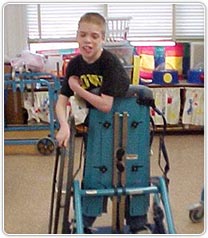 |
 |
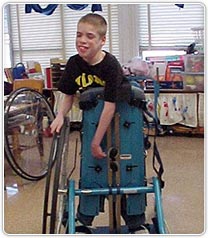 |
We used to think that there was a minimum motor criteria that a student would require to use a Mobile Stander. But over the years, we've found ways to position nearly every student in a Mobile Stander. It's a big plus. For students that hyper-extend their neck, we can thread the back strap with the fleecy part on it up and over in front of their shoulder, behind their neck, and then in front of the other shoulder. This fleece can essentially stop them from hyper-extending, and gives them the opportunity to stand in the most upright position we can provide for them. They can then turn their heads and look around without having to worry about hyper-extending.
This is how the fleece is threaded behind Tayah's head to keep her from hyperextending.
 |
 |
As a teacher, Lisa Perry loves the versatility of the Mobile Stander. "We start our day at a morning group meeting, where we talk about the day and what is going to happen. Some students come to the table in the Mobile Stander." For students who don't require complete and full support, we turn the stander around, so the student stands with their back against the body support, and the pad across the stomach. "They can still gain all the benefits from the stander," says Lisa, “but with the reverse position, they have open access to the materials that are on the table in front of them. They don't have to lean over or reach around the front of the stander.”
Several students who are ambulatory continue to use the Mobile Stander for various reasons. One little girl, Hunter, has some tightness in her hips, knees and ankles, so we stand her to improve joint range. She may never be a very fast walker, but when she's in the Mobile Stander, we have to run to catch up with her! She can move as fast as her friends or faster, which she will likely never do with walking. So she has that wonderful feeling of basically flying down the hall. For a little girl who we don't think always pays attention, she can stop with just a fraction of an inch between her and the wall or between her and any obstacle! Turn on a dime, change directions, practically pop-wheelies with it, she loves it.
Here's Hunter, the girl who can walk but goes really fast in the Mobile Stander. So fast it seems, we had a hard time getting an action shot! She’s too fast for the digital camera!
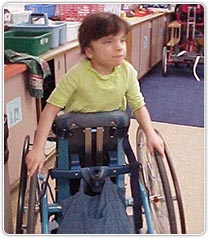 |
 |
Two students are now independent enough that they travel with items from Lisa's class to Mary's room. These students can do deliveries independently while in the Mobile Stander or in the Pacer, with a basket that is strapped on at the front to carry the objects. We have found that our students know a lot more than we thought: where they are in the building, and how to get from one room to the other. They would never have been able to demonstrate this independence to us without this equipment.
Elliot delivers snack supplies in a basket on the tray.
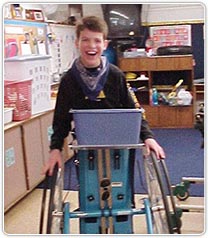 |
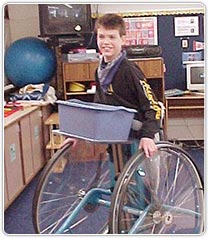 |
Several families over the years have been so impressed by our Mobile Standers here at school that we've worked with their insurance companies to purchase this product for home. Students who go to a summer program that is more like a day camp than school, can take their stander with them. I work with students up to 21 years of age; when our students turn 21, that's their last year at public school here, and they go on to a form of sheltered workshop. As their physical therapist, I try to get each of them at least one piece of equipment to take with them into adulthood, whether a Pacer, tricycle, or a stander. They may not have a therapist to advocate for them when they're over 21, and I want them to have at least one good alternative position for their adult life.
We strongly encourage teamwork between education and therapy, for the benefit of the students. There's no value in separating anybody's particular territory, or being possessive of 'this is the PT's job' and 'this is the teacher's job' and 'this is the OT's job.' We are all the advocates for the student, and whoever has that knowledge, we share it with one another. As a physical therapist, I can educate teachers and families, and empower students. As classroom teachers, Lisa and Mary can build on and further student motor abilities that are relevant for skills needed for their adult life. The Mobile Stander is a tool that we can all use for these purposes.
Back to Top